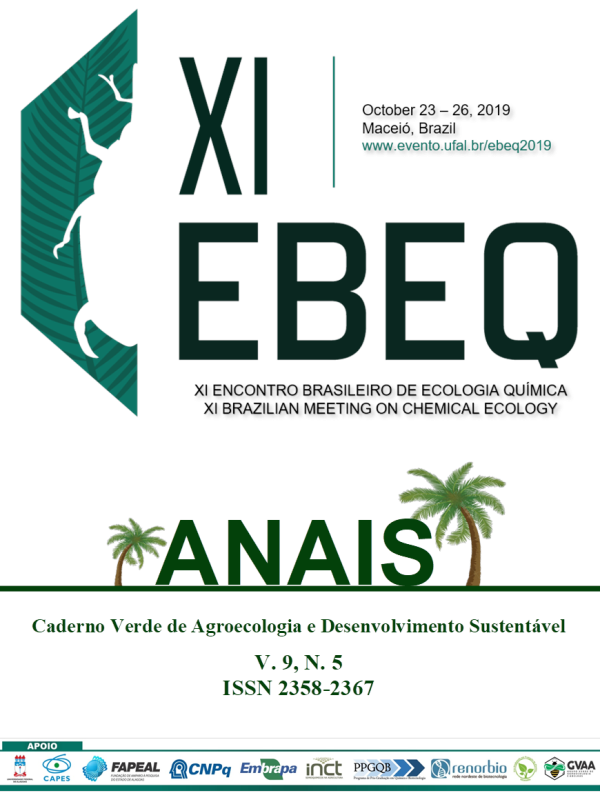IDENTIFICATION AND FIELD EVALUATION OF Opsiphanes invirae Hubner (LEPIDOPTERA: NYMPHALIDAE) EXTRACT COMPOUNDS.
Palavras-chave:
DEFOLIATOR CATERPILLAR, Arecaceas, HADSPACE, ELETROANTENOGRAPHIC, PALM TREE DEFOLIATOR CATERPILLAR, AGGREGATION PHEROMONE, MASS COLLECTION.Resumo
The species Opsiphanes invirae 1818 (Lepidoptera: Nymphalidae), known as the palm tree defoliator caterpillar, is a plague that attacks important plants of the Arecaceae family of socioeconomic interest. The use of sex pheromone has been considered an important tactic for the Integrated Pest Management. The objective of this study identify the occurrence of sex pheromone in both sexes, and as well as evaluate the attractiveness in field using the proposed aggregation pheromone mixtures. The research was carried out at the Laboratory of Natural Resources Research (LPqRN), Federal University of Alagoas (UFAL). The insects were collected at AGROPALMA farm, in Tailândia, Pará. The analysis of O. invirae male and female extracts in GC-FID and GC-MS revealed the presence of a specific compound in the male extracts. The compounds identified in the male extract of O. invirae were ocimene, linalool, nerolidol, hexadecene e heptadecene. Electroantenographic (EAG) bioassays were carried out with male and female extracts to investigate biological activity upon O. invirae antennae. The stimuli air, hexane, male extract and female extract were used in antennae. The data were submitted to analysis of variance and the means compared by Scott-Knott test at 5% of probability. The results demonstrated that female antennae presented no difference in responses to female extracts and the hexane. However, there was significant responses from female antennae to the male extracts. Regarding the male antennae, there was no difference between the responses to the hexane and the used extracts. The field evaluation with the constituents of the proposed O.invirae aggregation pheromone, demonstrated to potentiate the adult capture in the traps, contributing to the management of this pest.Downloads
Publicado
Como Citar
Edição
Seção
Licença
Termo de cessão de direitos autorias
Esta é uma revista de acesso livre, em que, utiliza o termo de cessão seguindo a lei nº 9.610/1998, que altera, atualiza e consolida a legislação sobre direitos autorais no Brasil.
O(s) autor(es) doravante designado(s) CEDENTE, por meio desta, publica a OBRA no Caderno Verde de Agroecologia e Desenvolvimento Sustentável, representada pelo Grupo Verde de Agroecologia e Abelhas (GVAA), estabelecida na Rua Vicente Alves da Silva, 101, Bairro Petrópolis, Cidade de Pombal, Paraíba, Brasil. Caixa Postal 54 CEP 58840-000 doravante designada CESSIONÁRIA, nas condições descritas a seguir:
O CEDENTE declara que é (são) autor(es) e titular(es) da propriedade dos direitos autorais da OBRA submetida.
O CEDENTE declara que a OBRA não infringe direitos autorais e/ou outros direitos de propriedade de terceiros, que a divulgação de imagens (caso as mesmas existam) foi autorizada e que assume integral responsabilidade moral e/ou patrimonial, pelo seu conteúdo, perante terceiros.
O CEDENTE mantêm os direitos autorais e concedem à revista o direito de divulgação da OBRA, com o trabalho simultaneamente licenciado sob a Licença Creative Commons do tipo atribuição CC-BY.
O CEDENTE têm autorização para distribuição não-exclusiva da versão do trabalho publicada nesta revista.
O CEDENTE têm permissão e são estimulados a publicar e distribuir seu trabalho online (ex.: em repositórios institucionais ou na sua página pessoal) a qualquer ponto antes ou durante o processo editorial, já que isso pode gerar alterações produtivas, bem como aumentar o impacto e a citação do trabalho publicado.








